From Medical News Today
Medical Center Accreditated by the American College of Surgeons:
The Beth Israel Deaconess Medical Center’s Carl J. Shapiro Simulation and Skills Center has been formally accredited as a Level 1 facility by the American College of Surgeons (ACS), the first in Boston and New England – and one of only six inaugural certified centers in the United States – to provide simulation-based skills training to health care students and professionals from all medical and surgical disciplines.
I would love to get that training.
Dr. Jon Mikel Iñarritu







